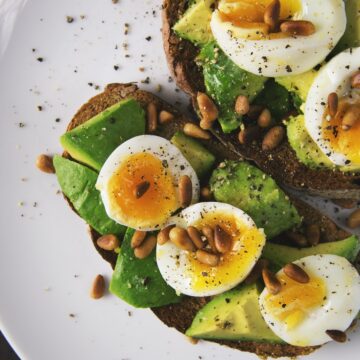
- You can lose weight and keep it off by creating new habits and focusing on small changes.
- Tracking your food is one way of knowing where to start making these changes.
- Instead of eating less and increasing your workouts, see a dietitian who can advise you on how to achieve your goals.
Diets work, until they don’t. But if you want to lose weight, these 5 habit changes might help do the trick, and for good.
1. Get a starting point

Tracking what you eat either through a journal or an app like My FitnessPal helps you work out where you can start making small but lasting changes.
“When working with clients, I find that tracking fiber intake, workouts, water and servings of vegetables can be very beneficial to losing weight,” says Daily Habits Nutrition dietitian, Mallory Spendlove, M.D.A., R.D.N.
2. Work with a dietitian

We tend to get into the “calories in, calories out” thinking, where we feel we’re losing weight by eating less and exercising more.
Work with experts such as dietitians instead. They can teach you how foods are digested, how much you should be eating for weight loss and how to achieve your goal while allowing you to enjoy all foods.
3. Fill half of your plate with vegetables

Instead of changing several aspects of your diet, just focus on changing one: your fiber intake. Although most Americans get 11-15 grams per day, aim for the recommended dose of 25-35 grams per day.
Vegetables are packed with fiber, which slows down digestion, making you feel full longer. It also hinders insulin spikes post meals. And unlike extra protein, carbohydrates and fat, excess fiber isn’t stored as fat.
Try the MyPlate or Healthy Plate framework of ½ vegetables, ¼ whole grains and ¼ protein, where a cup of veggies contains about 30 calories, while one cup of pasta has 200 calories.
4. Add protein, fiber and healthy fat to your morning meal

While research is mixed on whether we should eat or skip breakfast to lose weight, the most important thing is starting your day with a breakfast filled with fiber, protein and healthy fat.
Protein helps suppress the ‘hunger hormone’ ghrelin, and also boosts fullness hormones. Aim for 10 grams of fiber and 15-20 grams of protein. Eat when you’re hungry and not starving, otherwise you end up overeating.
5. Exercise

Diet changes accompanied with exercise is the most effective way of losing weight for good. According to the National Weight Control Registry, people who exercised for one hour per day lost 30 lbs and kept it off for a year or more. The exact amount of exercise and type varies from person to person.
While the CDC recommends 150 minutes of moderate-intensity exercise per week, others suggest 30-60 minutes per day and for weight maintenance, 30-90 minutes per day.
Aim for 30-60 minutes per day and least 15-20 minutes within 2-3 strength training sessions each week for a mix of cardio and resistance exercises.
How to keep going after you’ve lost the weight

Spendlove suggests starting small. Eventually, new small habits for weight loss add up and become second nature. By then, you’ll find yourself doing them unconsciously and don’t have to think about them all the time.
Weigh yourself once a week
While it doesn’t work for everyone, self-monitoring weight and food weekly are related with maintaining weight loss. Alert: Daily weights can be misleading because our weight fluctuates 2-4 pounds a day based on the amount of food and drink intake, or the time of day. “Other great indicators of progress are getting stronger at a work out, having clothes fit better, or comparing photos from before and during a weight loss journey,” says Spendlove.
Track food some more
If the number on the scale starts to rise, track your food again for 1-2 weeks and apply changes accordingly.
Add variety to your workouts
When our body gets too comfortable with our workout routine, it doesn’t burn as much calories anymore. Change things up by adding cardio if you’ve been doing a lot of strength training, or vice versa. Try upping the frequency, duration, or intensity of workouts as well.
Via Eating Well
